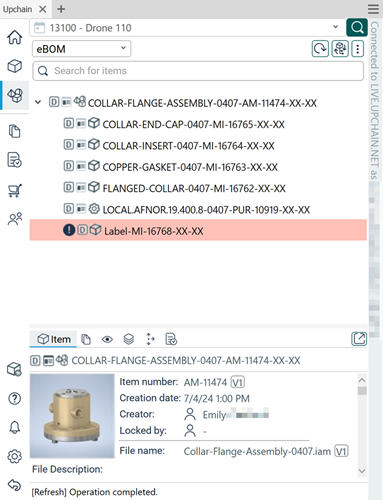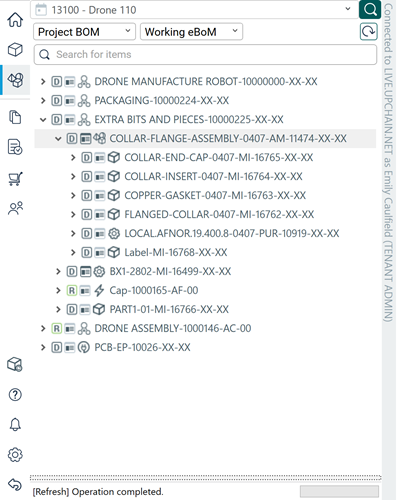About the bill of materials
A bill of materials (BOM) is a structured list of the assemblies, sub-assemblies, and parts needed to produce one unit of a finished product. Each finished product has its own BOM.
In Upchain, you may encounter three types of BOMs:
- cBOM: CAD bill of materials
- eBOM: Engineering bill of materials
- Project BOM: Project bill of materials
Additionally, Change notices generate an mBOM (Manufacturing bill of materials). However, this is not visible in Upchain.
cBOM
The cBOM is the CAD bill of materials. It is the BOM created in CAD software, that is, the design. It comprises the parts and assemblies in the design, and how they are linked together. Most commonly, you encounter and manage with the cBOM when working with one of Upchain’s CAD plugins.

eBOM
The eBOM is the engineering bill of materials. It is the BOM that represents the design structure within Upchain. It is the structured list of items that represent each part and assembly within the design as well as any additional items that would need to be purchased to fully assemble the final product, such as paint, grease, fasteners, and so on.

Generally speaking, every part and assembly file in the cBOM belongs to an item in Upchain. Therefore, for every part and assembly in the cBOM there is an associated item in the eBOM. In other words, the cBOM and eBOM are one-to-one.
There are exceptions to this:
You may have a file in the cBOM that is not registered to an item and therefore does not appear in the eBOM. These are called 'Phantoms' and are used where you do not want an item to appear on the eBOM, such as:
- Reference CAD
- Individual parts within a purchased assembly that would not be purchased separately
You may have items in the eBOM that do not appear in the cBOM, such as:
- Items that do not have or need CAD
- Fasteners that do not need to be modeled
- Grease, paint, oil, and so on.
In general, it is good practice to keep the cBOM and eBOM aligned throughout the design process because it provides visibility and clarity to other users who need to see and interact with the eBOM in Upchain.
Project BOM
The Project BOM is the entire structure of items within a project. It is essentially the eBOM for all items - which may include multiple end items (top-level items) - found within a project’s BOM section.

mBOM
The mBOM is the manufacturing bill of materials. The mBOM is generated from a change notice. Unlike the eBOM, which is organized with regards to how the product is designed, the mBOM is focused on the parts that are needed to manufacture a product. In addition to the parts list, the mBOM also includes information about how the parts relate to each other (known as the kitting number in Upchain). The mBOM is currently not visible in Upchain, but is an important component of the change notice process.